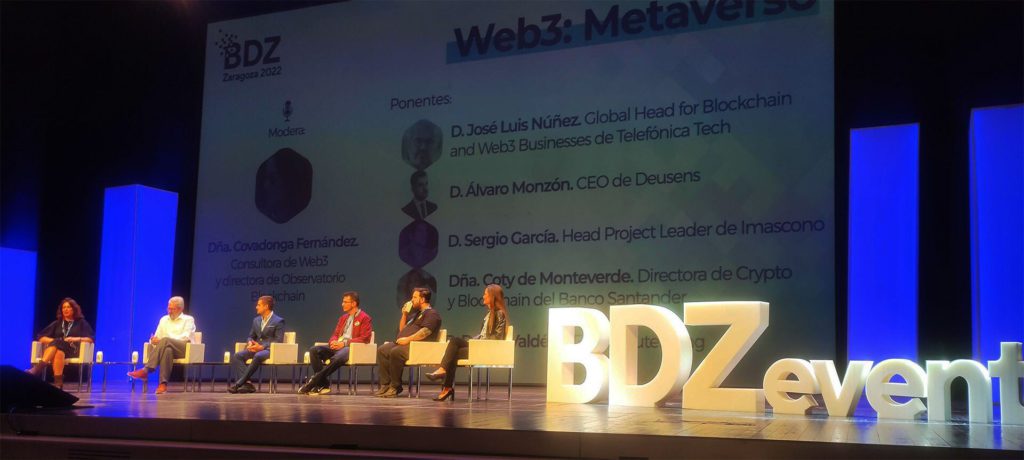The Spanish blockchain española has closed with good numbers and better sensations the first edition of the Blockchain Expo and DeFi Congress (BDZ), which has gathered in Zaragoza, on October 26 and 27, a large number of heavyweights of this thriving sector. The event, the first congress of its kind to be held in Spain, has received more than 1,200 visitors and 90 speakers and panellists, that have turned the capital of the Ebro into the national epicentre of blockchain, web3, metaverse and cryptoassets businesses.
The event was a showcase for remarkable advances in distributed ledger technology – the blockchain– in education or entertainment, as well as in the field of decentralised finance (DeFi). And, at the same time, it has made it clear that the industry assumes that mass adoption of this entire technological revolution based on decentralization and user sovereignty in matters such as personal identity is far from being just around the corner..
In fact, experts and representatives of the most innovative blockchain companies are clear that a new society, in which all these concepts will play a fundamental role in transforming how we relate to the world around us through technology, is yet to be built;. This is an interesting twist on player expectations. While a few years ago it was believed that the revolution was at our fingertips and that we were going to arrive in 2025 making payments with bitcoins or other currencies, it was not yet clear whether we would be able to make payments with bitcoins or other currencies in 2025; altcoins and wearing smart suits that will monitor and store our biodata in the blockchain, in the post-pandemic world, people are touching the ground while being acutely aware of the fact that they there is still a long way to go. And, most importantly, that we will walk together, “contributing from all sectors, from the most cutting-edge to the most traditional”, in the words of José Luis Núñez Díaz Global Head for Blockchain and web3 at Telefónica Tech.
 Degree of maturity
Degree of maturity
This is another axis of change and demonstrates the degree of maturity that the industry has reached in Spain, even though globally it is still in its adolescence (we must not forget that the blockchain is barely 14 years old). The big players and companies in the telecommunications and traditional banking sectors, such as the telecommunications Telefónica or Banco Santander, present at the conferences, have jumped on the bandwagon, which has changed the rules of the game in a substantial way, driving all of these developments and validating the fact that they are absolutely unstoppable.
The congress, which was attended by almost all the firms that have been driving the sector in recent years -comma has had the opportunity to talk to many of them and explore future synergies-, has been a meeting point for all these actors; In addition to those already mentioned, it is worth mentioning the participation of Tutellus, Bitbase, Bit2Me, Binance, Onyze, NEXXYO LABS, Polygon ID, DEXTOOLS, EOS Network Foundation, Chainalysis, Bitgo, Qredo, Polygonal Mind, Deusens, Rungie, Art.army or the incubator Monzón-e. To assume that the industry faces major challenges, to make a thorough list of all the unfinished business, and to outline courses of action and how to address them was, in my view, the main tone of this meeting;
Numerous challenges lie ahead;
The speakers agreed that, while the blockchain is deploying at a rapid pace, both metaverse as web3 are still very green and more theoretical than practical. Little has transpired about the new generation of the Internet, which is to replace web2.0, other than that it will be decentralised and revolve around the user and the wallet, a piece as fundamental as the browser was to the web1 , according to experts; Less clear is the metaverse, as the debate over virtual worlds and their future mission: whether they will offer the consumer only entertainment or something more, has been intense and remains open.
The main conclusion of the event was that the sector will only move forward on the basis of three pillars: more agreements between traditional and blockchain-based companies; integration of the crypto-asset payments in large banks, so that they can be custodians and the user can access their wallets intuitively and easily; and more regulation. In short, banks will be the spur to mass adoption, as they will bridge the gap for those customers who are new to the crypto world; However, to do so, they need the European Regulation onCrypto Assets (MiCA) to come into force. And that the European Union (EU) will enlighten MiCA II sooner rather than later, as this regulation leaves out DeFi and non fungible tokens (NFTs).
For comma, there is another great challenge: thatthe traditional media also be able to enter this revolution, recognize it and give it the place it deserves. The lack of coverage of the event in the general press or in the business media is surprising, but not in the specialised press or in local newspapers, which have reported on an event that has been promoted by BlockchainAragon and Feria de Zaragoza, with the collaboration of the Government of Aragon, the Zaragoza City Council and the Zaragoza Chamber of Commerce.


